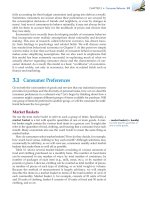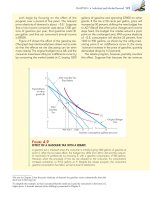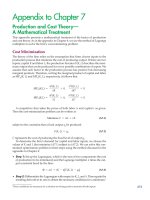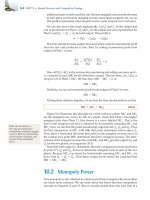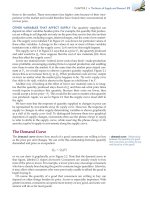(8th edition) (the pearson series in economics) robert pindyck, daniel rubinfeld microecon 118
Bạn đang xem bản rút gọn của tài liệu. Xem và tải ngay bản đầy đủ của tài liệu tại đây (118.93 KB, 1 trang )
CHAPTER 3 • Consumer Behavior 93
We can if we have information about a sufficient number of choices that
have been made when prices and income levels varied. The basic idea is
simple. If a consumer chooses one market basket over another, and if the chosen
market basket is more expensive than the alternative, then the consumer must prefer the chosen market basket.
Suppose that an individual, facing the budget constraint given by line l1
in Figure 3.18, chooses market basket A. Let’s compare A to baskets B and
D. Because the individual could have purchased basket B (and all baskets
below line l1) and did not, we say that A is preferred to B.
It might seem at first glance that we cannot make a direct comparison
between baskets A and D because D is not on l1. But suppose the relative
prices of food and clothing change, so that the new budget line is l2 and the
individual then chooses market basket B. Because D lies on budget line l2 and
was not chosen, B is preferred to D (and to all baskets below line l2). Because
A is preferred to B and B is preferred to D, we conclude that A is preferred to
D. Furthermore, note in Figure 3.18 that basket A is preferred to all of the baskets that appear in the green-shaded areas. However, because food and clothing are “goods” rather than “bads,” all baskets that lie in the pink-shaded
area in the rectangle above and to the right of A are preferred to A. Thus, the
indifference curve passing through A must lie in the unshaded area.
Given more information about choices when prices and income levels vary, we
can get a better fix on the shape of the indifference curve. Consider Figure 3.18.
Suppose that facing line l3 (which was chosen to pass through A), the individual chooses market basket E. Because E was chosen even though A was equally
expensive (it lies on the same budget line), E is preferred to A, as are all points in
the rectangle above and to the right of E. Now suppose that facing line l4 (which
passes through A), the individual chooses market basket G. Because G was chosen and A was not, G is preferred to A, as are all market baskets above and to the
right of G.
We can go further by making use of the assumption that indifference curves
are convex. In that case, because E is preferred to A, all market baskets above
and to the right of line AE in Figure 3.19 must be preferred to A. Otherwise, the
indifference curve passing through A would have to pass through a point above
Clothing
(units per
month)
l1
F IGURE 3.18
REVEALED PREFERENCE: TWO BUDGET LINES
l2
A
B
D
Food
(units per month)
If an individual facing budget line l1 chose market basket A
rather than market basket B, A is revealed to be preferred
to B. Likewise, the individual facing budget line l2 chooses
market basket B, which is then revealed to be preferred
to market basket D. Whereas A is preferred to all market
baskets in the green-shaded area, all baskets in the pinkshaded area are preferred to A.

